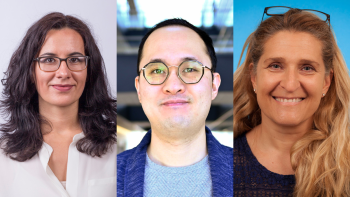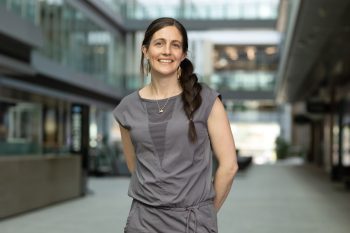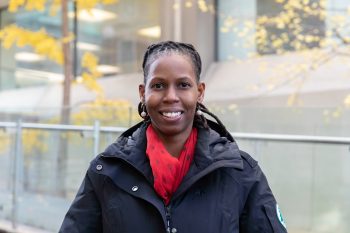What if we could identify the gene responsible for a baby’s heart defect, grow a piece of her heart on a chip and then test drugs to find the one able to shut down the defective gene?
A decade ago, that scenario seemed as far-fetched as a Mars landing. Now, University of Toronto researchers predict that these stunning achievements are just a few years away, thanks to the Ted Rogers Centre for Heart Research — a powerful collaboration between scientists from U of T’s engineering and medical faculties and physicians from SickKids and the University Health Network. The excitement is building as the Centre celebrates its first anniversary and U of T researchers prepare to move into the MaRS West Tower, which will be the Centre’s new home.
Writer Heidi Singer spoke about the Centre with Professor Craig Simmons (MIE, IBBME), who leads U of T’s collaboration as scientific director for the Translational Biology and Engineering Program.
Learn more about the Translational Biology and Engineering Program.
What is U of T’s role in the Ted Rogers Centre for Heart Research?
Our mission is to help discover the causes of heart failure and engineer therapies. We’re making fundamental discoveries about the mechanisms of cardiac diseases, discovering new biomarkers and building heart tissues with molecules, cells and biomaterials. The overall mission is to reduce hospital admissions due to heart failure by 50 per cent within 10 years. That’s very ambitious, but it can be done. The key is to bring everyone together: medical researchers, doctors, engineers and many other specialties.
Our new space will help make it happen. It’s state-of-the-art, highly integrated and interdisciplinary. We have a whole floor and eventually we’ll have 130 people there. Engineers will be sitting beside biologists who are sitting beside clinicians. This will spark collaborations that would never have happened otherwise.
Can you describe some of the most exciting work at the Centre?
Let’s say a baby is born with heart problems and a doctor at SickKids finds a gene associated with heart failure. Using stem cells from the baby, we can create a model of that child’s heart on a platform that looks like a chip. Then we can do personalized drug testing on the chip before the child ever swallows a pill. The technology exists now. I’m collaborating with a cardiologist who gets the stem cells from the patient and creates heart muscle cells. We put it on the chip. Then we would test drugs on it.
We’re also growing living replacement heart valve tissue in the lab. This could replace our current solution, which is mechanical heart valves that require people to be on blood thinners the rest of their lives. This is important for children because often we replace a valve in babies with fabric. That works for a bit and then they need multiple operations to replace it. What if we can get the baby’s cells from the umbilical cord and grow a heart valve that’s living tissue that will grow with the baby and adapt as the baby grows? We’re doing the same with blood vessels and heart muscle. Instead of using synthetics and other artificial replacements, we could use living replacements that would require one surgery to fully restore function.
We’re already in the early stages, and while we’re several years away from success, all the technology is in place. The demand is there. We know from the surgeons that the current state of the art isn’t great. The challenge now is to create tissues that are comparable to what’s in the body already.
You’re a mechanobiologist. Explain.
This is a field that’s been emerging over the past decade. We’re interested in how mechanical forces in the body affect cell function. We study the heart valve a lot. It opens and closes with every beat of the heart. The valve stretches and bends when blood rushes by. If you have high blood pressure or a malformed valve it causes even more mechanical stress, contributing to valve disease. Most people think of something in the blood, like cholesterol, causing heart disease. But cells react to mechanical forces. One day we’ll make a drug that desensitizes heart cells to mechanical forces.
Dream a bit. What will cardiac care look like in 50 years?
We’ll have injectable biomaterials and molecules to help the heart heal itself. Some animals, like zebrafish, can do it. Whatever gene allows them to do it, maybe we can turn that gene on in humans.
In addition, our ability to grow your exact heart cells in a lab will allow us to conduct drug trials in a Petri dish instead of on an animal. This will give us lightning-fast results. It’s taking some of the guess work out by eliminating something that’s going to fail. Right now drugs are screened in animal models that don’t match up to human biology perfectly. That’s one reason why most promising research falls apart when we get to human trials, which is why it costs so much and takes so long to develop a drug. We could eliminate those false positives sooner and develop personalized drugs for your heart.
Is there anything like the Ted Rogers Centre for Heart Research anywhere in the world?
It’s unique in terms of the number and diversity of people we have. There’s the potential to be in the top five in the world for cardiovascular research and maybe the number one in the world for heart failure. That will come to fruition if we can bring everyone together and synergize. That’s where we’ll really see the potential fulfilled.
Read more about the Ted Rogers Centre for one-year anniversary.



